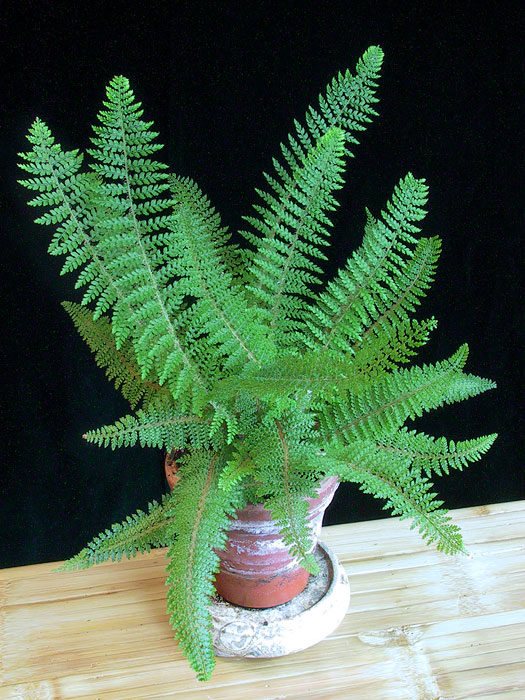| Polystichum setiferum | ||
Soft shield fern | ||
|
Etymology
Setiferum is from saeta, a bristle or stiff hair + fero, to bear or carry.
Description
Rhizome: erect.
Frond: 150 cm high by 15 cm wide, evergreen, monomorphic, blade/stipe ratio: 3:1, but more in juveniles. Stipe: grooved, mixed large and small, golden-brown scales, the largest corn flake-like, vascular bundles: 4 or more, in an arc. Blade: 2-pinnate, lanceolate, widest at the middle, soft-textured, rachis and costa (less so) scales linear to wooly, golden brown. Pinnae: 30 to 40 pair, 6-8 cm, the lower pinnae bending forward, the lowest 45�; pinnules fat, short, the basal lobe upwards or outwards enlarged; costae grooved above, discontinuous with the rachis; margins serrate, spiny; veins free, forked. Sori: round, in 1 row between the pinna midrib and margin, indusium: peltate, shriveling upwards like an inverted umbrella, green young, golden brown, tan at end, central, sporangia: dark brown. Culture
Habitat: lowlands, near water, but not wet, a moderate calcicole.
Distribution: western and southern Europe, east to the Caspian.
Hardy to -20�C, USDA Zone 6.
Distinctive Characteristics
The soft texture, large size, numerous fronds, and very scaly stipe and rachis characterize P. setiferum.
Synonyms
Polypodium setiferum Forsskal Polystichum angulare (Wild.) C. Presl Aspidium angulare Kit. ex Willd. Hypopeltis hastulata Tod. Dryopteris setifera Woynar |
|
|
|
Polystichum setiferum. Part of pinna, peltate indusia, first segment of the pinnule�pointing towards the pinna tip enlarged, spiny margins, all characteristics typical of Polystichum. �BioImages: The Virtual Field-Guide (UK), photo � Malcolm Storey. |
